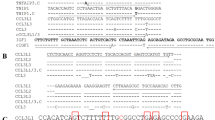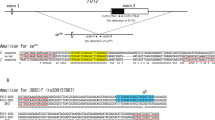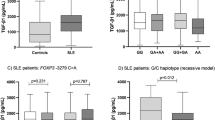Abstract
The fourth component of complement (C4) in man, is coded for by two separate but closely linked loci (C4A and C4B) within the major histocompatibility region (MHC), on the short arm of chromosome 61. Like class I and II loci of this region, the C4 genes are highly polymorphic with more than 30 alleles, including null alleles, assigned to the two loci2. This extensive polymorphism, based mainly on electrophoretic mobility, provides a useful marker for studies of disease susceptibility. Several disorders, including systemic lupus erythematosus and type I diabetes3,4, show associations with C4 phenotypes. We have used the technique of Southern5 with a C4 specific probe6 to examine the genomic DNA of individuals typed for C4 by protein electrophoresis. We have identified 10.7 and 3.8 kilobase (kb) BglII restriction fragments in each of 9 unrelated individuals with a C4A67,8 allele, and in none of 22 unrelated individuals in whom this allele was not expressed. This clear correlation of restriction fragment length polymorphism with C4 phenotype provides a precise basis for analysis of C4 polymorphism. It is likely to be of value in clinical investigations of autoimmune disease.
This is a preview of subscription content, access via your institution
Access options
Subscribe to this journal
Receive 51 print issues and online access
$199.00 per year
only $3.90 per issue
Buy this article
- Purchase on Springer Link
- Instant access to full article PDF
Prices may be subject to local taxes which are calculated during checkout
Similar content being viewed by others
References
Raum, D., Donaldson, V. H., Rosen, F. S. & Alper, C. A. Curr. Topics Haemat. 3,111–174 (1980).
Mauff, G. et al. Immunobiology 164, 184–191 (1983).
Fielder, A. H. L. et al. Br. med. J. 286, 425–428 (1983).
McCluskey, J. et al. Diabetologia 24, 162–165 (1983).
Southern, E. M. J. molec. Biol. 98, 503–517 (1975).
Carroll, M. C. & Porter, R. R. Proc. natn. Acad. Sci. U.S.A. 80, 264–267 (1983).
Teisberg, P., Olaisen, B., Thorsby, E. & Gedde-Dahl, T. Jr Immunobiology 158, 91–95 (1980).
Awdeh, Z. L. & Alper, C. A. Proc. natn. Acad. Sci. U.S.A. 77, 3576–3580 (1980).
Maniatis, T., Fritsch, R. F. & Sambrook, J. (eds) Molecular Cloning: A Laboratory Manual. (Cold Spring Harbor Laboratories, New York, 1982).
Sykes, B. C. Lancet. i, 787–788 (1983).
Author information
Authors and Affiliations
Rights and permissions
About this article
Cite this article
Palsdottir, A., Cross, S., Edwards, J. et al. Correlation between a DNA restriction fragment length polymorphism and C4A6 protein. Nature 306, 615–616 (1983). https://doi.org/10.1038/306615a0
Received:
Accepted:
Issue Date:
DOI: https://doi.org/10.1038/306615a0
This article is cited by
-
Design and Validation of a Colorimetric Test for the Genetic Diagnosis of Hemochromatosis Using α-Phosphorothioate Nucleotides
Biochemical Genetics (2013)
-
Possible association of sudden infant death with partial complement C4 deficiency revealed by post-mortem DNA typing of HLA class II and III genes
European Journal of Pediatrics (1989)
-
Class III gene rearrangements in Thai/Chinese supratypes containing null or defective C4 alleles
Immunogenetics (1988)
-
Bgl II restriction fragment length polymorphism of human complement C4A gene coincides with BF * F allele of factor B
Immunogenetics (1988)
-
Polymorphism of MHC class III genes: definition of restriction fragment linkage groups and evidence for frequent deletions and duplications
Human Genetics (1988)
Comments
By submitting a comment you agree to abide by our Terms and Community Guidelines. If you find something abusive or that does not comply with our terms or guidelines please flag it as inappropriate.



